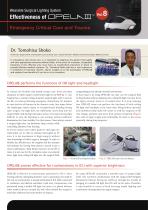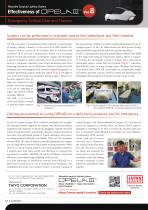 Website:
OPELAIII
Website:
OPELAIII
Group: Taiyo Corporation
Catalog excerpts

Wearable Surgical Lighting System Effectiveness of Emergency Critical Care and Trauma Professor, Department of Emergency and Critical Care, Tokyo Women’s Medical University Adachi Medical Center In emergency and critical care, it is important to diagnose the patient thoroughly and take appropriate measures without delay. In the event of a disaster, designated hospitals in the affected area must have an established procedure in place to provide effective medical response. Dr. Tomohisa Shoko who has a vast experience in treatment of traumatic injuries, shares insights as to the advantages of OPELAⅢ and explains how beneficial it can be in crisis situations. OPELAⅢ performs the functions of OR light and headlight At critical care facilities that handle tertiary care, there are many situations in which surgery is performed right in the ER Fig.1)Our ( . compounding to the already stressful environment. In that respect, by using OPELAⅢ, not only can the surgical field be illuminated without adjusting the ceiling OR light, but also focus the light precisely where it is needed most. It is truly amazing how OPELAⅢ alone can perform the functions of both ceiling OR light and headlight at the same time. Being battery-operated and untethered help make life easier as well for surgeons at ER who change positions and move their posture frequently (Fig.2). hospital has a normal ceiling-mounted surgical light with 2 arms in the ER, yet when performing emergency thoracotomy for instance in cases such as rib fracture in the thoracic cavity, liver injury below the diaphragm, spleen injury or retroperitoneal bleeding during open surgery, the light does not sufficiently reach deep into the surgical field. And during hemostatic suture, it becomes increasingly difficult to stop the bleeding in one attempt without sufficient Also with its light weight and comfortable fit, there is less stress illumination for clear visibility. For this reason, I have always wanted especially during long surgeries. a surgical light that can illuminate deep cavities while controlling shadows from forming. In severe trauma cases where patient’s vital signs are unfavorable yet no time to examine thoroughly by CT scan, it is not uncommon to begin surgery without clear knowledge of which organ is damaged. In order to identify the affected area, the surgeon and the assistant will examine by moving their posture around to get a visual confirmation. With limited resource in the ER at times, it is not easy for the circulation nurse to accurately direct light from ceiling OR light into the surgical field, Fig. 1︱Scene at ER treating head injury Fig. 2︱OPELAⅢ main unit and battery OPELAⅢ proves effective for tracheostomy in ICU with superior brightness OPELAⅢ is effective in tracheostomy performed in ICU’s. Since moving patients undergoing intensive care to operating room adds to the risk, as tracheostomy is usually performed in ICU while connected to ventilators and dialysis machines. Until now, tracheostomy was performed using a mobile OR light, but since it is placed between other medical devices around the bed, often behind the surgeon’s head thus shadows form and interfere in surgery. By using OPELAⅢ, technically a movable type of surgical light itself, now I perform tracheostomy with the surgical field brightly illuminated without having my staffs go through the trouble of bringing in a mobile OR light into ICU and vie for space. Therefore, I reap benefits in terms of both securing ample lighting and convenience of pr
Open the catalog to page 1
Wearable Surgical Lighting System Vol. Emergency Critical Care and Trauma Surgery can be performed in cramped spaces like ambulance and field hospital We hold emergency preparedness drills regularly in anticipation of surgery during a disaster. In the event of an NBC disaster for instance, various section of the hospital must be sanitized and cordoned off to prevent contamination before even accepting patients for first aid treatment or emergency surgery. We developed a special emergency vehicle especially for such an incident to be used as a temporary operating room where hemostasis and...
Open the catalog to page 2All OPELAIII catalogs and technical brochures
-
OPELA III BROCHURE
2 Pages
-
OPELA III Instruction Manual USA
28 Pages
-
OPELA III Instruction Manual
28 Pages











